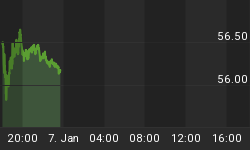Below are extracts from recent commentaries posted at www.speculative-investor.com.
Short-term interest rates and the stock market
The following chart compares the performance of the S&P500 Index with the performance of the yield on a 2-year Treasury Note. Clearly, over the 8-year period covered by this chart the 2-year interest rate and the US stock market have moved in lock-step, that is, rising trends in short-term interest rates have invariably been accompanied by rising trends in the stock market, and vice versa. Notice, for example, that the 2-year interest rate and the S&P500 bottomed together during October of 1998 and then rallied together into the first half of 2000. Notice, as well, that the S&P500 embarked on a major bear market in March of 2000 while the 2-year yield began a major bear market of its own a couple of months later; and that within 3 months of the March-2003 beginning of a cyclical bull market in the S&P500 Index the 2-year yield began to trend relentlessly higher.

Now, short-term interest rates in the US are controlled by the Fed. The above chart therefore makes the case that the Fed's monetary policy has been, and continues to be, strongly influenced by what is happening in the stock market. Specifically, the chart implies that the Fed can be relied upon to cut interest rates in response to persistent stock market weakness and to hike interest rates in response to persistent stock market strength.
We think the chart's message is that the Fed will continue to hike the official short-term interest rate until after US equities commence their next bear market. The idea that the stock market outlook is bright because the Fed is about to end its rate-hiking is therefore nonsensical since the thing that is most likely needed in order for the Fed to end its rate hiking is the commencement of a large and lengthy downturn in the stock market.
Bonds
The global bond market is the setting of some of the most interesting developments happening in the financial world at this time. The first of the following two charts, for example, shows that US Treasury Bond futures have just closed below important support and are now at their lowest level since July of 2004, whereas the second chart shows that Japanese Government Bonds have completed a massive multi-year top formation to end their secular bull market and are now at their lowest level in more than 5 years.


We expect that there will be sufficient additional weakness over the next few months to take US T-Bond futures below major support defined by the August-2003 and May-2004 lows, but making short-term bets against them doesn't appeal to us. There are two reasons for this. First, bonds are very oversold so there is a significant risk that a sharp counter-trend rebound will temporarily interrupt the decline. Second, there are easier ways to make money than to bet against the world's most manipulated market.
It is not too late, however, for investors to sell (to exit long-term positions in) government bonds. As weak as bonds have been over the past nine months, current yields do not come close to compensating investors for the inherent inflation risk. Furthermore, although the 30-year US T-Bond has not yet unequivocally confirmed the onset of a secular bear trend by breaking below the bottom of what we interpret to be a large topping pattern, the 10-year US T-Note HAS provided this level of technical confirmation (as, of course, has the Japanese bond market).
In our opinion, one of the surest ways to generate a negative real return on investment over the next several years would be to invest, at today's prices/yields, in the long-dated bonds issued by the governments of the world's major economies. Furthermore, corporate bonds and other higher-yielding bonds -- emerging-market government debt securities, for instance -- look even less attractive because credit spreads are very narrow right now (investors are currently not being paid a reasonable amount for assuming the additional credit risk). Even the so-called "inflation protected" bonds are likely to provide negative real returns because these bonds don't protect their holders against the ACTUAL effects of inflation; they only protect them against the effects of inflation admitted-to by the government.
But what if you are in the financial position of needing the guaranteed income stream provided by bonds? In this case you should, perhaps, consider US Government debt securities with durations of 5 years or less. This is because with the US yield curve almost totally flat you wouldn't be settling for less interest income by opting for shorter-duration securities and you'd be taking-on less inflation risk.















